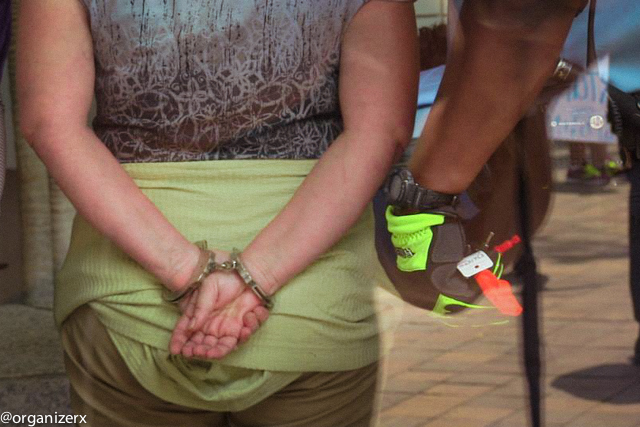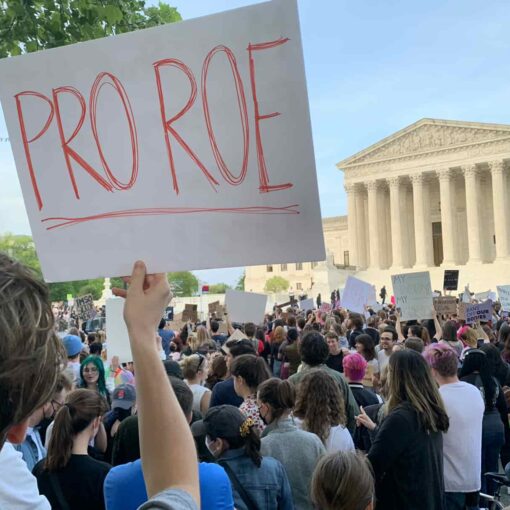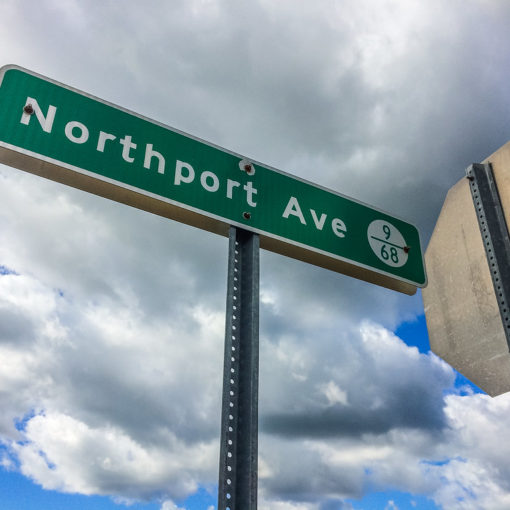WashingtonDC—George Washington University students along with students from other universities, supporters from the local community, and some local allied groups, have joined the rising wave of university campus protests currently sweeping the nation. Unlike many other university encampment protests, police and campus security have failed to persuade students to leave and not successfully ejected them from the University Yard, which students have renamed “Liberated Zone.”
Students are protesting the continued War and destruction of Gaza by Israel, and laid out five demands to University Administration for its role in supporting Israel. They are also demanding revocation of the suspension of seven students involved in the protest. Other demands include university divestment from Israel.
The round-the-clock occupation of University Yard began Thursday morning at 5:45 am when a small group of about 20 began occupying the center of the yard and put up a handful of tents. University security and DC Metropolitan Police quarantined the student protesters by erecting metal barricades along the edge of the University Yard facing H Street, the only side fully open to the street. Supporters gathered outside the barricades to provide moral support. A standoff ensued as campus security and police attempted to force them out of the yard, according to a student witness who declined to give their name. Security and DC Metropolitan Police, denied the students bathroom access, food and water, but supporters were able to provide limited relief over the next four days according to the witness.
Outside University Yard more supporters joined on H Street over the next few days to give the students encouragement as the standoff grew.
On Sunday night at about 10:45 PM, dozens of MPD moved in to arrest the 20 students who remained firmly planted in the yard. But supporters stormed and overwhelmed the security and police, de-arrested one student, and stopped any more arrests. The unplanned quick action empowered the supporters who then scaled the barricades to join the students in the center of the yard. The students dissembled the barricades and the University Yard turned into a full-fledged resistance as hundreds joined in the occupation.
The encampment has grown 10 fold since Sunday night and has now been ongoing a week since last Thursday. Over 153 tents in total have been erected in University Yard which includes 16 additional tents erected on H Street.
University Yard Transformed Into A Gaza Solidarity Resistance
The encampment has continued to expand and hold firm as of noon on Wednesday night. More students and supporters have volunteered and joined in the University Yard as word of the GWU occupation spread on social media and in the press. The number of tents increased slightly to about 160 on Wednesday night. The tents include a medical tent, an open library, a food tent, an elongated and continuously operating kitchen tent with a staff of about three providing free cooked meals to anyone who stops by, an art supply tent, meeting spaces, and unisex bathroom tents complete with disposable waterless sanitation systems. Most tents are personal residences where student protesters can rest, change, and repose. It is difficult to ascertain how many are involved in the occupation but at a minimum several hundred are in the park at any given time with many coming and going to classes.
The “Gaza Campus” as they have named it, is also called “Liberation Zone” and has in its center a banner draped pillar of the unevenly stacked metal barricades which were torn down and haphazardly stacked at the climax of the attempted raid late Sunday night.
Students Say Gaza Campus is About Gaza Not About Students
Students are quick to say they’re not there for themselves but standing in for the Palestinians of Gaza. During an early Tuesday afternoon teach-in, over 300 circled in the center of the University Yard to hear speakers discuss the deteriorating conditions in Gaza. They discussed their five demands to the University Administration and their intention to remain in an indefinite occupation until their demands are met: some of which include University divestment from Israel, a moratorium on giving financial support to Israel, and reinstatement of seven students suspended for their roles in the “Gaza Campus” 24-hour vigil on Sunday night.
GWU Gaza Campus: Transforming Resistance
Most protests in Washington DC over the last two decades have been a gathering of hundreds or thousands in a local park with informal speeches, followed by a march through streets with signs; everyone returns home, and everything seems to go back to the way it was. Commerce and traffic return to normal. Washington DC has grown accustomed to this routine. Even the MPD script street closures by the numbers and are as efficient as an atomic clock closing roads.
The round-the-clock University Yard occupation is different. It has become a major thorn in the GWU Administration’s side if not just because it is growing and gathering more supporters, more students, but because it is continuous and gaining more and more support and by the day. The occupation of University Yard is an eyesore for anyone who prefers neatly combed green grass edged with flowering gardens, smarly trimmed bushes, and thick trunked trees aged over 100 years old; the way any ivy league school should be. Yes the flowers have been trampled and the grass has been flattened a bit after a weeks-long occupation. But students have added a sign at the entrance in response, reading, “Don’t like the encampment, keep looking away like you did for genocide.”
The yard’s flowers will bloom again next spring and the grass will regrow once the students leave. But for now the students are standing off against those complicit and unwilling the fix the underlying forces destroying Gaza and its Palestinian communities.
A Walk Through The Gaza Campus
The first thing one sees upon entering the square is that the bronze statue of George Washington has been retransformed from a statesman to the infantry infidel he once was. In the late 1770s his fledgling Army skirmished with the well-supplied and better equipped British forces occupying the rebellious Colonies. He resisted British rule and the British saw him as an insugent. But this time around, George Washington the infidel is wearing a checkered kufiya around his neck and tagged with motifs of the Palestinian resistance. By Wednesday afternoon someone had moved his kufiya up over his head and his neck so that only his eyes are peering out towards H Street. As signs are taken away, more signs are being added to his pedestal: “American compliance nurtures Palestinian Genocide” reads one, “Ceacefire in Gaza Now” reads another and it is the sign at George’s base.
And nearly everyone visiting the University Yard stops to take a picture of the newly repurposed infidel George Washington as he once was and as he is now.
Behind him is a white board with community standards written in green ink:
–No Zionism
–Clean up after yourself and our space
–Ask questions
–Don’t talk to police
–Don’t talk to media unless trained
–hydrate
–grace and patience
–self advocate
–No substances
–No sexual relations
–Respect one another
–Be disciplined
–Have revolutionary optimism
–Do not lose sight of Gaza (written in red)
To the right of George is the Liberation Library, free pop-up library in a tent with a carousel of books about resistance and revolution. A sign requests visitors to return books on the honor system. A copy of Frank Herbert’s Dune is on the shelf as is The Autobiography of Malcolm X, Mohandas Ghandi Essential Writings, Girl Zines, Palestine Studies, and Saving Our Own Lives (A Liberatotory Practice of Harm Reduction) by Sbira Hassan; except that the last word in the title, “Lives,” has been blotted out by black paint, probably accidentally. Many others discuss principles of revolution, self empowerment, and community building. There is a row on Zines laid on the floor; among them, “De-arrest Primer,” “First We Take Columbia (Lessons From the April 1968 Movement,” “DC To Palestine (Linking Our Liberation),” and “Fuck Identity, We Need Solidarity (Pittsburgh Radical Perspective).” Zines are usually anonymously written black and white discussion booklets providing practical guidance for community challenges.
By Wednesday night, Liberation Library has been renamed Reefat Alareer Memorial Library after the Palestinian Poet and writer who was killed in Gaza along with his brother, sister, and their children during an air attack on December 6, 2023.
By the following day, “Dune” has been checked out and other books such as “White Lies” authored by Berger, and “Azerbaijan“ by Soja Bolukbasi have replaced it.
Someone has hand written a poem on parchment titled “I Brought You White Roses,” and left it on the book carousel. It reads, in part:
“In case your mom wasn’t able to pick them up from the souk
I’d like to think you can hear the drum echo from my district to the one your heart beats in
There’s so many cameras
Does it feel like the world is watching your extinction?
Across from the library is a medical tent and team of medical staff; a sign above it reads “Please do not photograph the medical tent.”
Nearby someone has set down a row of portable plant pots, named it the “People’s Garden,” and left a sign requesting someone to check on it and to please water it if the soil is dry. Spouts include Lavender, Mint, Dill, Basil, and rosemary.
The kitchen team is continually busy, its student servers efficiently provide to scores free cooked meals outside the University Yard on H Street. On the menu Wednesday night is black beans and rice, chicken wings and drums, vegan meals with noodles and vegetables, falafels, and salads. There’s coffee, doughnuts left over from the afternoon, and confections from the Middle East and they all taste pretty good. Everything is donated from local restaurants or from the community.
There is another support tent nearby with snacks, hygiene products such as toothpaste, toothbrushes, soft drinks, energy drinks and energy bars. The students staffing it urge everyone to take whatever they need since there is more than what is needed. Every few minutes someone from the community drops off more support donations for the students.
Along every pathway are chalked messages written by students of their hope for a free and peaceful Palestine. Students are constantly building signs and painting banners to display throughout the University Yard. Signs are taped on the walls of the buildings surrounding the yard on three of its sides. Nearly every sign will be moved by the next day or replaced by other signs.
Encampment Sets Beacon of Hope
Throughout the day many from the community visit the encampment. Visitors include notable personalities from past campaigns and organizations from across the region. Union organizers, founders of social justice organizations, and supporters are flocking to Gaza Campus. May Day saw a worker’s forum held in the yard center amidst the stacked barricades. Later on a march for Palestinian freedom numbering in the hundreds ended at the encampment and filled the yard with additional supporters chanting for a long time. Their chanting and drums could br hears a few blocks away. They finished chanting so evening prayers could begin. Dozens kneeled on straw mats as an imam intoned the evening prayers.
In a corner by a wall a group of five Latin-American men play resistance songs on their guitars while one sings the lyrics. In the yard center a long greyed haired octogenarian sits and speaks to students gathered around him. Press from around the world walks through the yard recording the tents and banners and captures the scene while a field news person speaks to their audience back home.
Like ripples from a stone tossed into water, the student’s’ activities spread influence through the community and to distant shores abroad. An organizer noted they received thanks from families in Gaza who learned of their solidarity protests. One can never know the full effect on others of their actions, especially since so much attention is focusing on the university protests. But based on the police response in other cities, the protests are working, even if just to focus attention from other world issues.
The effect of the encampment would be limited if not for the students’ intensions and harmonized reflections on themselves as beacons of change. Their interactions with others is peacefully calm and their resistance is in a respectful yet assertive manner. Actions are seemingly taken by individuals without words spoken. One could surmise that there are meetings over channels on a forum chat somewhere online but tasks are completed all around the yard without public discussion. There’s a lot at stake and a 4 year education could be taken from a student for their involvement. Without prompting, some paint posters, others pick up trash and serve food, banners are painted, moved and repurposed; an organizer hails the camp over a set of speakers calling out “Mike Check!” several times until everyone is listening and then reminds everyone of the demands and purposes for their occupation; they are there and not leaving; be mindful of others studying for finals; reflect carefully about intentions; everything they have in the yard—food, water, shelter, medical help, education, and companionship—has been denied to Palestinians.
Many students sit or lay on mats outside their tents and appear preoccupied on their laptop screens and seem disengaged from the Gaza Campus. This is because they are focusing on their last classes of the year and on their final exams. Being involved in a sustained resistance while preparing for college finals is as stressful a situation as any student could place themself. But theres a sign posted on a tree nearby in response to such a musing. It reads: “There are no universities in Gaza.”






